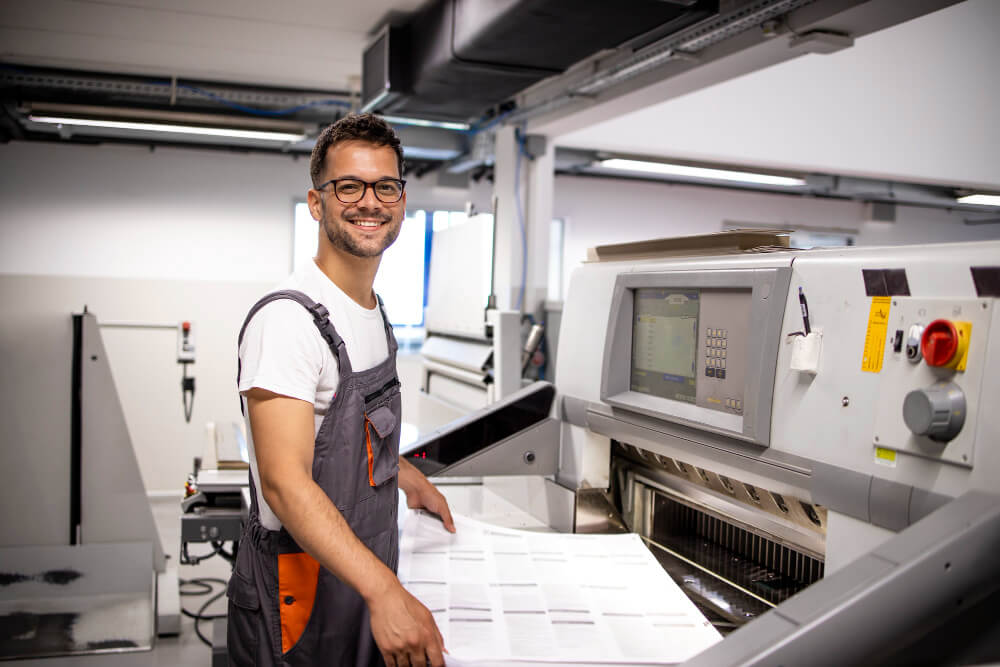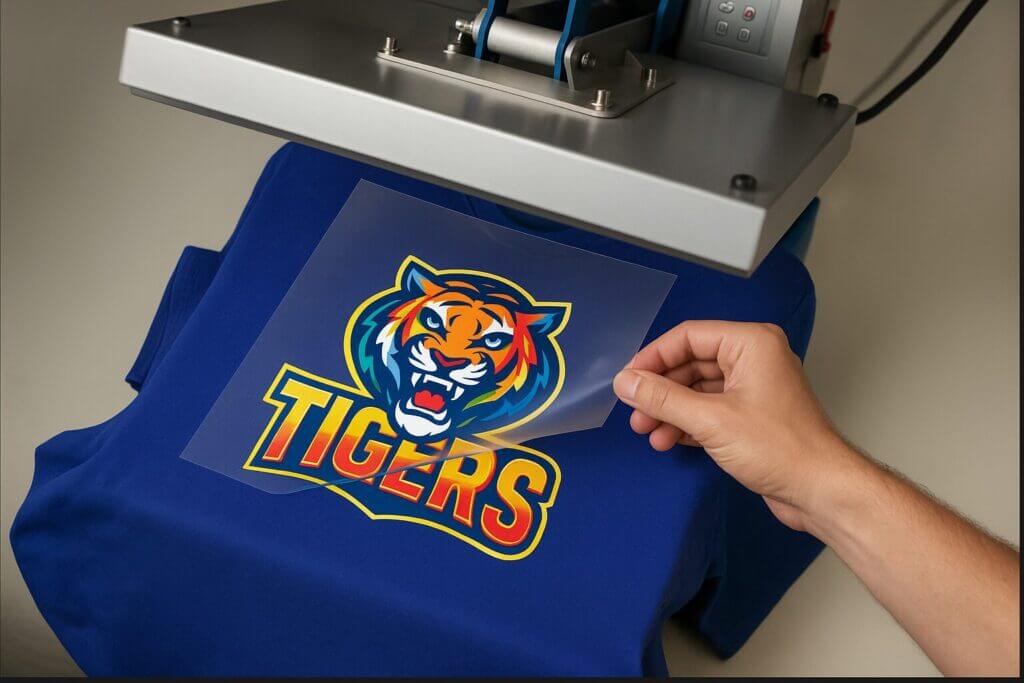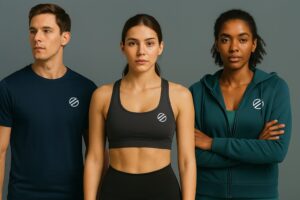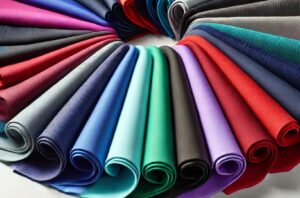If you’ve ever had a uniform print peel off after one wash or fail to stick to polyester, you’re not alone. Many print methods have limitations, especially when working with sportswear materials. That’s where Direct-to-Film (DTF) printing comes in.
DTF uses a printed film and adhesive powder to create full-color, high-quality designs that stay sharp and flexible. It’s a reliable option for decorating sports uniforms and custom activewear.
What Is DTF Printing?
DTF stands for Direct-to-Film. It’s a printing method where your design is printed onto a clear film, coated with adhesive powder, and then transferred onto a garment using heat.
What makes DTF different is how the design bonds to the surface of the fabric, instead of soaking into the fibers like DTG or sublimation. The result is a bold, slightly raised finish that stays vibrant, even after lots of stretching, washing, and daily wear.
DTF works on a wide range of fabrics, including cotton, polyester, blends, spandex, and nylon. That versatility makes it a strong choice for custom apparel, especially when you’re printing on tricky materials like sportswear or activewear.
And it’s not just a trend. According to industry reports, the global DTF printing market hit USD 2.72 billion in 2024 and is expected to grow at about 6% per year through 2030. It also made up around 68% of all digital textile printing that year. This shows how widely it’s being adopted by print shops, merch brands, and apparel manufacturers.

How the DTF Process Works
Direct-to-Film (DTF) printing is known for producing bold, flexible prints, and the process behind it is surprisingly straightforward. Here’s a step-by-step look at how it works, from digital design to final garment.
Step 1: Print the Design onto Film
First, your design is printed onto a DTF-specific PET film, but it’s flipped horizontally like a mirror image. This is because the film will be placed face-down on the fabric, and flipping it makes sure the design appears the right way once transferred.
DTF printers use water-based pigment inks in CMYK (cyan, magenta, yellow, and black) to build the colors in your design. After the color is printed, a white ink layer is added on top of it. This white layer becomes the base that helps colors stay bold and visible, especially on dark fabrics.
Without this step, your design could fade into the shirt color or lose its sharpness. That’s one big reason DTF works so well across all fabric types and colors.
Step 2: Apply Adhesive Powder
While the ink is still wet, a layer of hot-melt adhesive powder, is applied to the back of the film. This powder, usually TPU-based, sticks only to the printed areas. After shaking off the excess, you’re left with a targeted adhesive layer that will later bond to the garment surface.
Timing is important. If the ink starts to dry, the powder won’t adhere properly. Ideally, you should apply it within 30 to 60 seconds of printing. In automated setups, this is done as part of the print line. If you’re doing it by hand, sprinkle the powder evenly across the film, then gently shake or tap off the excess.
This adhesive layer is what allows DTF prints to bond well with a wide range of fabrics, including cotton, polyester, spandex, blends, and nylon.
Step 3: Cure the Film
Next, the printed film is cured using a heat tunnel, oven, or hover press. The heat melts the adhesive powder just enough to activate the glue, without smudging the ink. Typical curing temperatures are around 250–280°F (120–140°C) for 2–3 minutes.
After curing and cooling, the film becomes a ready-to-use transfer. You can apply it right away, or store it for later use. Most transfers stay good for several weeks or longer if kept flat and dry.
Step 4: Heat Press onto the Garment
To transfer the design, place the cured film face-down on the garment and press it using a heat press set to 290–320°F (145–160°C) for 10–15 seconds. Use medium to firm pressure to make sure the adhesive bonds properly.
Depending on the film type, you’ll either peel it while it’s still warm or wait for it to cool (this is usually marked on the film or product instructions). Many decorators also do a quick second press (2–5 seconds) using parchment or Teflon paper. This helps lock in the design and smooth the finish, especially for commercial-grade results.
The result is a full-color print that stays bright, soft, and flexible, without any pretreatment or complicated cleanup. It stretches with the garment and holds up through repeated washing and wear.
Pros of DTF Printing
Here are some of the key benefits of DTF printing that make it a smart option for sports uniforms and performance gear.
1. Durability
One of the key reasons decorators choose DTF for sportswear and performance gear is its long-lasting durability. High-quality DTF prints typically withstand 50 to 100 wash cycles without fading, cracking, or peeling. It is comparable to screen printing, which has long been the industry standard for wash resistance.
The secret lies in the combination of water-based pigment inks and TPU-based adhesive. The ink holds color well over time, and the adhesive stretches with the fabric instead of cracking.
Compared to DTG, which often starts to fade after 20 to 50 washes, or heat transfer vinyl, which may peel or crack on stretch garments, DTF offers a more dependable option. That means whether you’re outfitting a team or selling gym gear, your prints will stay sharp through an entire season, and likely much longer.
2. Sharp Details
DTF printers use high-resolution settings, typically at 300 DPI or more, and some setups can go as high as 720 to 1440 DPI. That level of precision helps your designs come out crisp and clean, even when printed small. Tiny lines and soft fades stay sharp, which is especially useful on logos, chest emblems, or multicolor graphics.
Compared to screen printing, which uses halftone dots at 45–65 lines per inch (LPI), DTF has a clear advantage for fine artwork. Screen printing works great for bold shapes and solid colors but often struggles with sharp edges and small type.
Another bonus: because DTF is digital, every print comes out the same—no need to align layers or worry about tiny misprints. That means your detailed designs stay consistent, from the first shirt to the hundredth.
3. Fast Customization
DTF printing makes it easy to customize each garment with names, numbers, or logos. Instead of cutting vinyl or burning new screens, you simply update the digital artwork and print a new film. There’s no extra setup or manual alignment required, which speeds up production for team orders and personalized merchandise.
According to ColDesi, DTF cuts setup time by 50–70% compared to screen printing, especially for multi-color designs. Transfers can be printed, cured, and stored in advance, making it perfect for on-demand or team orders.
With vinyl, manual steps like cutting and weeding can add 3–5 minutes per garment. DTF removes those steps, speeding up production and reducing labor without sacrificing quality.
Cons of DTF Printing
While DTF has a lot going for it, there are a few things to be aware of when deciding if it’s the right fit.
1. Limited Breathability
If you are printing for athletes or activewear, breathability is a big concern, and DTF can fall short when covering large parts of a garment. Because the print sits on top of the fabric instead of soaking in, it creates a physical barrier that can block airflow. On lightweight shirts, mesh jerseys, or performance gear, this may cause the fabric to trap more heat and moisture than intended.
This is not much of an issue with small logos or text, but larger prints, especially full-front or back designs, can affect how the garment feels during long wear or intense activity. Compared to sublimation, which dyes the design directly into the fabric and preserves airflow, DTF printing is less breathable when covering larger areas.
2. High Upfront Cost
Starting DTF printing in-house takes more than just a printer. You’ll need a DTF-compatible printer with white ink support, a powder application station, a curing oven or heat tunnel to set the adhesive, and a heat press for final transfer. Entry-level setups typically cost between USD 5,000 and 10,000, while more advanced systems can reach USD 20,000 or more, depending on speed, print size, and automation features.
This investment is similar to DTG, which also requires a pre-treatment machine and high-maintenance printers. But it’s still lower than screen printing, where equipment for multi-color jobs, including screens, drying tunnels, and exposure units. It can push costs well above USD 25,000 for commercial setups. DTF also has an edge over heat transfer vinyl, which is cheaper to start with but far more labor-intensive for large orders or complex designs.
Because of the space and cost requirements, many small businesses choose to outsource DTF printing and just press the transfers themselves. It’s a simple way to offer vibrant, personalized prints without taking on the full setup.
3. Air Quality and Maintenance Needs
DTF printing uses TPU-based adhesive powder, which becomes airborne during application and curing. In poorly ventilated spaces, this can irritate the respiratory system and, for some, cause skin or eye sensitivity. Safety guidelines recommend using a local exhaust system, fume extractor, or downdraft table to keep air clean during production.
You will also need to keep the workspace clean. Regular printhead maintenance, powder cleanup, and airflow management are essential for keeping equipment running smoothly and protecting the working environment. For small setups, this may require more space and daily upkeep than other methods.

How to Get Started with DTF Printing
If you’re ready to explore DTF printing, this section will help you decide whether to print in-house or outsource, and what tools or partners you’ll need to get started.
Is In-House Printing a Good Fit for You?
If you’re weighing whether to bring DTF printing in-house or outsource the film printing, the real question is: what do you gain or give up either way?
In-house DTF gives you faster turnaround, more control over quality, and lower cost per print in the long run. But it also means upfront investment (typically USD 5,000–10,000), daily maintenance, and a workspace with ventilation and powder control.
Outsourcing, on the other hand, lets you skip equipment and overhead. You just order ready-to-press films and focus on garment application. The trade-off is slower lead times and less flexibility if your artwork or orders change often.
Here’s a quick way to decide: If you need flexibility for fast-turn orders or want to avoid delays from ordering transfers, in-house printing makes sense. If you’re working with low volumes or just getting started, outsourcing film production is a simpler and more cost-effective way to begin.
Entry-Level DTF Printers
You don’t need to spend $20,000 to get started. There are entry-level DTF printers under $7,000 that can deliver commercial-grade results for small businesses and custom apparel decorators. Below is a comparison of three trusted options.
Top 3 Entry-Level DTF Printers
| Model Name | Price Range | Print Size | Key Features | Best For |
|---|---|---|---|---|
| Epson L1800 (Converted) | $600 – $800 | A3 | Low cost, CMYK+White support, suitable for beginners. Slower speed. Requires daily maintenance to avoid clogs. Ideal for small batch work. | Beginners with low volume needs |
| Prestige A3 / XP600 | $1,000 – $1,300 | A3 | Faster than L1800, supports bulk ink and white ink. Reliable for moderate use. Needs routine cleaning. Curing and powder units sold separately. | Small shops with moderate output |
| Brother GTX Pro (Converted) | $2,500 – $3,000 | A3+ | Strong color accuracy, faster print speeds, higher brand reliability. White ink ready. Better suited for frequent production. | Small businesses needing higher speed |
Finding a DTF Printing Manufacturer
If you’re not ready to invest in equipment, working with a DTF transfer manufacturer is a practical way to get started. Many businesses choose to outsource the printing step and focus only on pressing the transfers in-house.
When evaluating suppliers, look for those that offer high-resolution prints with CMYK and white ink, use TPU-based adhesive powder for durability, and provide options for cold or warm peel. Reliable turnaround times and regional availability are also important, especially if you’re running time-sensitive orders.
You can find DTF manufacturers on platforms like Alibaba, ThomasNet, Printify, or through local trade suppliers. Always request samples first so you can test color accuracy, stretch, and wash performance before committing to bulk orders.
Final Thoughts
DTF printing has earned its place as a reliable solution, not just a short-term trend. It’s a smart solution for brands and decorators working with activewear and sports uniforms. It slashes setup time compared to screen printing, handles fine details more easily, and works reliably on mixed-fabric and dark garments, unlike sublimation.
At Sphere Sport, we specialize in delivering high-quality uniforms with complete customization. With our in-house DTF printing capabilities, you get teamwear printed and pressed professionally, with no need to manage transfers or handle complex printing workflows yourself. That means faster turnarounds, consistent output, and a hassle-free experience.
Have a team order, event kit, or custom run coming up? Contact us to see how we can support your uniform needs with our streamlined DTF-based printing service.






